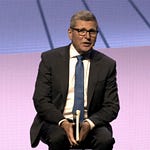When The Skeptical Environmentalist was published in 2001, it landed like a meteor in the middle of the environmental debate. Its author, Danish political scientist Bjørn Lomborg, dared to ask uncomfortable questions and insisted on evidence-based answers. Almost a quater of a century on, his central thesis remains the same: the world faces real environmental challenges, but we’re misallocating resources by focusing on the wrong ones—and often exaggerating the problems we claim to be solving.
In this conversation, Lomborg revisits the foundations of his work and the reaction it provoked, offers a clear-eyed assessment of climate policy, and outlines how we might get better outcomes—not by panicking, but by prioritising smart, cost-effective solutions.
We’re spending $27 trillion to get $4.5 trillion back. That’s not climate policy—that’s bad economics.
Lomborg began his environmental journey as a worried idealist. A member of Greenpeace in his youth, he embraced the apocalyptic language that dominated the movement in the 1980s and 90s. But everything changed when he encountered the work of American economist Julian Simon, who argued that many environmental indicators were improving, not deteriorating. Lomborg’s instinct was to prove Simon wrong. Instead, digging into the data with his students, he discovered much of what Simon said was true.
Air pollution, for example, has been in long-term decline in most wealthy nations. London’s air quality, Lomborg notes, has been improving since the 1890s and is now cleaner than at any point since medieval times. The lesson: when societies become wealthier, they invest in fixing problems. And when it comes to air quality—one of the most lethal environmental threats, killing 4–5 million people each year—that investment has saved lives.
Many environmental reports immediately pivot to panic. Why? Because fear sells.
The backlash to his data-driven optimism was fierce. Lomborg found himself vilified by many in the environmental movement. “I thought we were going to have a discussion about numbers,” he said. “But we were having a discussion about feelings.”
He discovered a paradox at the heart of environmental advocacy: many of the people demanding that we “follow the science” weren’t pleased when he quoted the science back to them. Reports from the UN and other global bodies often contain good news buried beneath doomsday headlines—yet it’s the worst-case scenarios that dominate media coverage, fundraising pitches, and public discourse. Fear sells. But it also distorts.
If you really want to save the planet, invest in innovation—not in telling people to be poorer and colder.
Lomborg doesn’t deny the reality of climate change. What he questions is the apocalyptic framing and the policy response. “Climate change is a problem,” he says. “It’s not the end of the world.”
The best economic models, including those from Nobel laureates like William Nordhaus, suggest that unchecked climate change will reduce global GDP by 2–3% by 2100. That’s a real cost, but not an existential threat. Even accounting for that loss, the average person in 2100 will be 450% richer than today—or slightly less, at 435–440%.
So why are we spending trillions as if we were facing an asteroid impact? Lomborg argues that the Paris Climate Accord may represent the largest misallocation of resources in history. A 2023 study by top climate economists found that it would cost $27 trillion annually to deliver $4.5 trillion in benefits—a deeply lopsided equation.
For $31 a year, you can triple a child’s learning. That’s real impact. That’s smart spending.
If the current strategy is flawed, what should we do instead?
First, Lomborg calls for a pivot away from coercion—telling people to be colder, poorer, and less mobile—and toward innovation. Only by developing green energy sources that are cheaper than fossil fuels can we hope to see widespread global adoption, including in countries like China, India, and across Africa.
He invokes the Green Revolution of the 1960s, which solved looming food shortages not by rationing or redistribution, but by technological innovation in agriculture. The same model, he argues, can apply to energy and climate.
Second, he urges governments and NGOs to look beyond climate. The Copenhagen Consensus Center, which Lomborg leads, works with top economists and Nobel laureates to identify the most cost-effective interventions globally. Their conclusion: climate change is just one of many pressing issues—and not the most urgent.
What delivers the greatest return on investment? Programs that fight malaria, tuberculosis, child malnutrition, and poor education. One example: giving children in developing countries access to personalised tablet-based education for just $31 a year can triple their learning outcomes, lifting productivity and earnings for decades. That $31 investment has an estimated long-term value of $2,000—a return that dwarfs most climate spending.
The Paris Agreement may be the biggest misallocation of resources in human history.
Lomborg is particularly scathing about Europe's energy policies. Germany, he says, spent over half a trillion dollars on wind and solar while shutting down its nuclear industry—only to see rising emissions, higher energy prices, and the deindustrialisation of its economy.
The problem isn’t just the intermittency of renewables—it’s the failure to account for it. Solar and wind may appear cheap “when the sun is shining and the wind is blowing,” but when they’re not, they’re infinitely expensive, and fossil fuel backup is still required. “It’s like being told a solar car is cheaper than your petrol car,” Lomborg quips, “but it only works when it’s sunny—you still have to buy both.”
The economic pain caused by these policies, he warns, is fuelling political backlash—seen most clearly in the rise of populist movements across Europe and the resurgence of Donald Trump in the US. “If you scare people and make them poor, they will revolt.”
We told kids the world was ending. It’s not. It’s time to talk them off the ledge.
What animates Lomborg’s work is not ideology, but a commitment to data and economics. He believes passionately in the power of numbers to cut through political noise and identify what actually works. His latest book, Best Things First, showcases 12 smart, underfunded solutions that could transform global development for a fraction of current climate spending.
These include health interventions, education reform, land rights, and even e-procurement systems to reduce corruption. Together, they could save 4.2 million lives a year, lift millions out of poverty, and generate $52 of benefit for every dollar spent. All for $35 billion a year, a rounding error compared to the $2 trillion we now spend annually on climate policy.
Eventually, people vote out governments that make them poor. The climate movement ignores that at its peril.
Is he hopeful that governments are finally waking up?
“Yes, a little,” Lomborg says, though he’s learned to temper his optimism. Policymakers and voters are starting to feel the cost of bad decisions, and eventually, they will demand change—if not for the right reasons, then out of necessity.
His final message is clear: stop doing the stupid stuff, start doing the smart stuff. Focus on innovation, spend wisely, and recognise that our challenges are real—but solvable.
Bjørn Lomborg Director of the Copenhagen Consensus Center
















Share this post